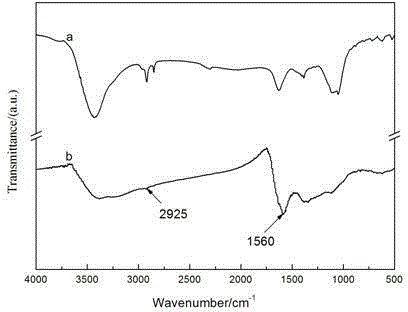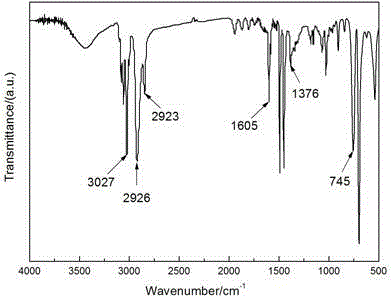Method for quickly functionalizing graphene with covalent polystyrene
A technology of polystyrene and graphene, which is applied in the treatment of dyed low-molecular organic compounds, dyed high-molecular organic compounds, fibrous fillers, etc., can solve the problems of poor compatibility between graphene and organic polymers, and achieve monomer Wide application range, extremely applicable surface for a single unit, and simple steps
- Summary
- Abstract
- Description
- Claims
- Application Information
AI Technical Summary
Problems solved by technology
Method used
Image
Examples
Embodiment 1
[0028] A method for covalently functionalizing graphene with polystyrene quickly, the specific steps are as follows:
[0029] 1) Preparation of graphene oxide: graphene oxide prepared by Hummers method: add 1.0 g of dried flake graphite, 1.2 g of potassium nitrate, and 46 ml of concentrated sulfuric acid into a 250 ml four-necked flask, and mix them evenly under the action of ultrasound , then stirred in an ice-water bath and slowly added 6.0 g of potassium permanganate. Subsequently, the temperature of the reaction system was raised to 40° C., and the reaction was stirred at high speed for 6 hours. Then, while slowly adding 80 milliliters of distilled water, the system was heated up to 70° C. and reacted for half an hour. Then add 100 milliliters of distilled water and 6 milliliters of hydrogen peroxide (mass percentage concentration is 30%) to the system, and stop the reaction after 5 minutes to obtain a bright yellow graphene oxide mother liquor, and add an appropriate amo...
Embodiment 2
[0041] Weigh 50 milligrams of polystyrene covalently functionalized graphene and add it to 50 ml of THF, and ultrasonically disperse it for 5 minutes. Experiments show that polystyrene covalently functionalized graphene has good dispersion in THF. There is no delamination, and the dispersion effect of polystyrene covalently functionalized graphene in THF is shown in Figure 7 (a).
Embodiment 3
[0043] Solvent is DMF, and other conditions are the same as embodiment 2, and experiment shows, polystyrene covalently functionalized graphene has good dispersibility in DMF, puts 6 months and does not see delamination, polystyrene covalently functionalized graphite See the diagram of the dispersion effect of alkenes in DMF Figure 7 (b).
PUM
 Login to View More
Login to View More Abstract
Description
Claims
Application Information
 Login to View More
Login to View More - R&D
- Intellectual Property
- Life Sciences
- Materials
- Tech Scout
- Unparalleled Data Quality
- Higher Quality Content
- 60% Fewer Hallucinations
Browse by: Latest US Patents, China's latest patents, Technical Efficacy Thesaurus, Application Domain, Technology Topic, Popular Technical Reports.
© 2025 PatSnap. All rights reserved.Legal|Privacy policy|Modern Slavery Act Transparency Statement|Sitemap|About US| Contact US: help@patsnap.com



